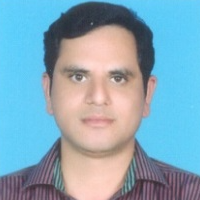
Dharmanna L
Work place: Sri Dharmasthala Manjunatheshwara Institute of Technology, Mangaluru, 577221, India
E-mail: dharmannasdmitu@gmail.com
Website:
Research Interests: Medical Informatics, Image Compression, Image Manipulation, Image Processing, Medical Image Computing
Biography
Dr. Dharmanna Lamani obtained M.Tech degree from VTU, Belagavi. He was awarded Ph.D. in computer science and engineering from VTU, Belagavi. His research interest includes Medical Image Processing, Embedded System design, Pattern Recognition and Computer Networking. He has published around 30 papers in reputed Journals and Conferences.
Author Articles
A Novel Approach for Early Detection of Neovascular Glaucoma Using Fractal Geometry
By Chandrappa S Dharmanna L Basavaraj Anami
DOI: https://doi.org/10.5815/ijigsp.2022.01.03, Pub. Date: 8 Feb. 2022
Neovascular glaucoma (NVG) is a human eye disease due to diabetes that leads to permanent vision loss. Early detection and treatment of it prevent further vision loss. Hence the development of an automated system is more essential to help the ophthalmologist in detecting NVG at an earlier stage. In this paper, a novel approach is used for detection of Neovascular glaucoma using fractal geometry concepts. Fractal geometry is a branch of mathematics. It is useful in computing fractal features of irregular, asymmetrical, and complex natural objects. In this work, fractal feature-based Neovascular glaucoma detection from fundus images has been proposed. It utilizes the image adjustment enhancement technique as a preprocessing method to improve the accuracy of NVG detection and the box-counting technique of Fractal geometry to estimate the fractal dimension. The proposed system is tested over MESSIDOR and KMC datasets and yields an average accuracy of 98%.
[...] Read more.An Automatic Recognition, Identification and Classification of Mitotic Cells for the Diagnosis of Breast Cancer Stages
DOI: https://doi.org/10.5815/ijigsp.2021.06.01, Pub. Date: 8 Dec. 2021
The identification of breast cancer stages plays a vital role for understanding the aggressiveness of cancer disease and the patient survival as an outcome. The main parameter of breast cancer staging is counting the mitotic cells in biopsy samples of breast cancer tissues. In the present scenario the manually counting of the mitotic cells in histopathology image slides of the tissue examined by the expert under clinical microscope is 10X, 20X ,40X ,100X,400X magnification of the sample. The manual process is laborious, inaccurate, erroneous and tedious, hence the traditional method demands the computerized approach to recognize and identify the cancer stages for the expert to come up with robust decision. In this work we proposed a novel approach for automatic recognition and identification through computer aided diagnosis systems (CAD). In this CAD proposed model the work is divided into five stages. In the first stage histopathological image are preprocessed to enhance the contrast of the mitotic cells and non mitotic cells using image adjustment technique. In second stage the foreground and background is segmented using Otsu segmentation algorithm. In the third stage the Bit plane slicing is applied to separate the mitotic and non mitotic cells. In the fourth stage the number of mitotic cells is counted in the samples. In the fifth stage of the work, based on the number of mitotic cells the cancer stages are determined. In this work, ICPR 2012 database images are adopted for the experimentation. The diagnosis of the stage of the cancer will help the oncologist to take proper decision and also reduces the burden of the work.
[...] Read more.Design and Development of IoT Device to Measure Quality of Water
By Chandrappa S Dharmanna L Shyama Srivatsa Bhatta U V Sudeeksha Chiploonkar M Suraksha M N Thrupthi S
DOI: https://doi.org/10.5815/ijmecs.2017.04.06, Pub. Date: 8 Apr. 2017
The conventional method of measuring the quality of water is to take the samples manually and send it to laboratory for analysis. This technique is time overwhelming and not economical. Also it is not feasible to take the water sample to the laboratory after every hour for measuring its quality. To overcome from these problems a new system is proposed in this work. This water quality measuring system will measure the essential qualities of water in real time. The proposed system consists of multiple sensors to measure the standard of water, Raspberry Pi 2 and Ethernet Local Area Network (LAN) to send the information to the controlling center. It's a real time system which is able to endlessly measure the standard of water and send the measured values to the controlling center in each predefined time. The system relies on sensors, Raspberry Pi 2 and Internet.
[...] Read more.A Novel Approach for Diagnosis of Glaucoma through Optic Nerve Head (ONH) Analysis using Fractal Dimension Technique
By Dharmanna L Chandrappa S T. C. Manjunath Pavithra G
DOI: https://doi.org/10.5815/ijmecs.2016.01.08, Pub. Date: 8 Jan. 2016
According to the survey of World Health Organization (WHO), the number of people getting affected by glaucoma eye disease in worldwide will be 79.11 million by the year 2020. Glaucoma is a dangerous eye disease, which can lead to permanent vision loss if not provided proper treatment at the right time. Currently ophthalmologists detect the glaucoma disease based on estimation of cup to disk ratio, but this method suffers from accurate segmentation of regions like optic disk and optic cup. However, this introduces errors in the diagnosis. Therefore in this paper, Hausdrop Fractal Dimension (HFD) technique is adopted for identification of the glaucoma eye disease. Here, Optic disk perimeter parameter is used in HFD technique for classification of healthy or glaucomatous retinas. Average fractal dimension is calculated for a set of healthy optic disks and the fractal dimension is found to be 0.998, whereas for glaucomatous optic disks obtained average fractal dimension value 1.342.
[...] Read more.Other Articles
Subscribe to receive issue release notifications and newsletters from MECS Press journals